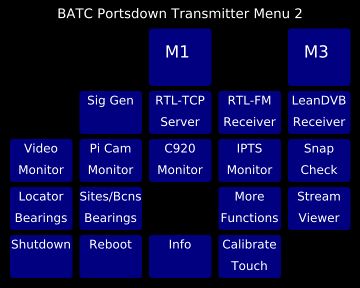Difference between revisions of "Portsdown 2020 Receive Enhancements"
| Line 1: | Line 1: | ||
| − | Software version | + | Software version 202004302 introduced significant enhancements to the Receive and video-handling functionality of the Portsdown. |
===LNB Voltage Switching=== | ===LNB Voltage Switching=== | ||
Latest revision as of 20:41, 8 May 2020
Software version 202004302 introduced significant enhancements to the Receive and video-handling functionality of the Portsdown.
LNB Voltage Switching
For those users who have made G4KLB's LNB Voltage Switching board Serit_LNB_DC_supply, the Portsdown will now switch the supply between "off", 13V and 18V. It will not turn the tone on (as would be required to receive the top end of the commercial Ku Band).
This function can be selected from the "RX", "Config" menu, where the button cycles through 3 states: "LNB Volts Off", "LNB Volts 18 Horiz" (as required for DATV on Es'hail-2) and "LNB Volts 13 Vert". The chosen setting is stored in the configuration file and applied every time receive is selected.
VLC Video Player
The 3 video players available for the receiver are the simple "H264 No Audio" player, "OMX Player", which should display MPEG-2 and H264 signals with audio, and the recently introduced "VLC Player".
The advantage of VLC player is that it will display some H265 signals. It will tear or "fold-over" the picture on H265 signals where the vertical height is not divisible by 32. So pictures that are 576 pixels high are OK, but not 720 (use 704 and it works) or 1080 (use 1056 or 1088). Some MPA audio streams do not work with VLC, but do work with OMXPlayer.
VLC player is not compatible with simultaneous display of the signal parameters, so these are obscured as soon as a valid image is displayed.
One other advantage is that VLC player will decode the audio from the Wideband Beacon, although not the video.
Note that the use of UDP streaming to an external (Windows or Linux) desktop PC remains the most reliable way to display signals.
Screen capture (Snap) is available in all the video players by touching the far lower left of the display. There is, as yet, no indication of a valid snap (see below).
Screen Capture "Snap"
It is possible to store a screen capture ("Snap") of the display when receiving using the Portsdown Receiver, or when using the Comp Video, Pi Cam, C920 or IPTS Monitors. In all cases the Snap is triggered by touching the lower left corner of the touch screen (to be precise, the lower 1/6 and the left 1/8). There is no confirmation of the snap at the time.
Snaps can be viewed from the "Snap Check" button on Menu 2. If there are no snaps stored, then the button will do nothing (a brief flash of the Portsdown Logo). If there are multiple snaps stored, the most recent is displayed first. You can cycle through all of the stored snaps backwards by touching the lower left of the screen, and forwards by touching the lower right. Touching elsewhere exits the snap viewer.
The snaps are also available for transmission as stills in "Composite Video" output mode.
All the captured images are permanently stored in the folder /home/pi/snaps on the Raspberry Pi. The easiest way to access these images is to use a Windows application called WinSCP which can be downloaded from https://winscp.net/eng/download.php. Connect your RPi to the same network as your computer and log-in to the RPi using WinSCP. You can then copy the images from the /home/pi/snaps folder to your Windows computer. Note that there is also a file called snap_index.txt in the folder which contains the index number of the next image to be stored.
If you want to clear all the images off your RPi, simply delete them and set the number in snap_index.txt back to 0. If you have a 16 GB memory card, there is currently enough free space for at least 40,000 images, but deletion is recommended before 1000 images have been captured.
Composite Video Monitor
The "Video Monitor" available on Menu 2 enables the video input to the EasyCap to be displayed on the touchscreen. It is reduced in size to 540x432 pixels (75% of original size) as 720x576 overflows the current screen, and more complex size reductions (to fill the available screen space) overload the RPi processor which would result in jerky playback. There is currently no audio passthrough, but it is hoped to add this soon. Screen captures of the monitor can be taken by touching the lower left corner of the screen. Touching elsewhere exits playback.
If full definition (720x576) screen captures are required, these are still available, but without any preview, from "Menu 2", "More Functions", "Video Snap"
Pi-Cam, C920 and IPTS Monitors
In a similar way to the Video Monitor, the Pi Cam, C920 and IPTS Monitors (and the Stream Viewer), are available on Menu 2 and can be screen captured as snaps.
The IPTS Monitor and Stream Viewer also replay audio; the Pi Cam and C920 monitors currently do not.
Note that the C920 has also been added to the Composite video menu as an available video source (no audio yet). This means that the Pi Cam is no longer the only available Portsdown camera device available for use as a source for portable analogue TV - the C920 can be used instead.
